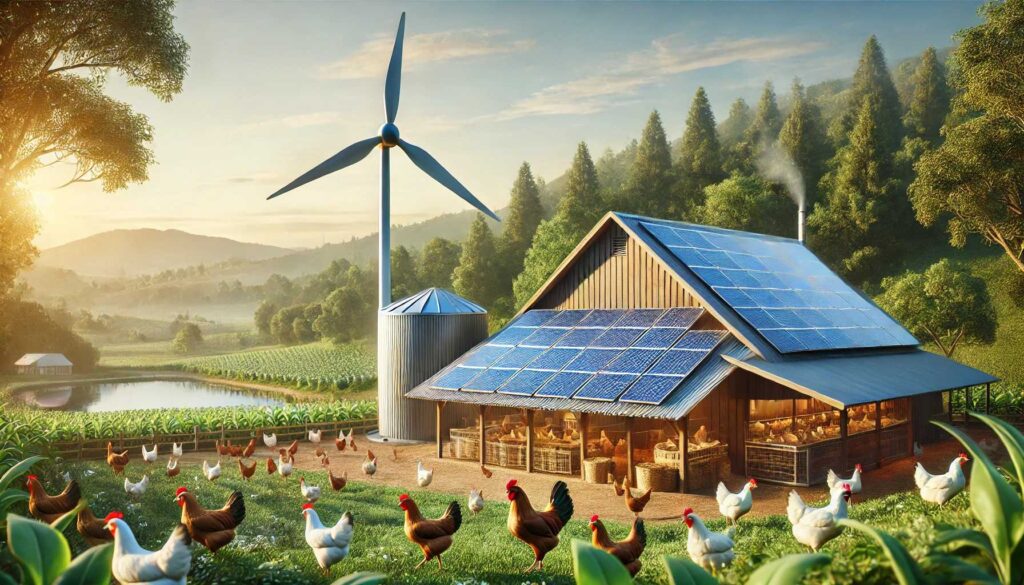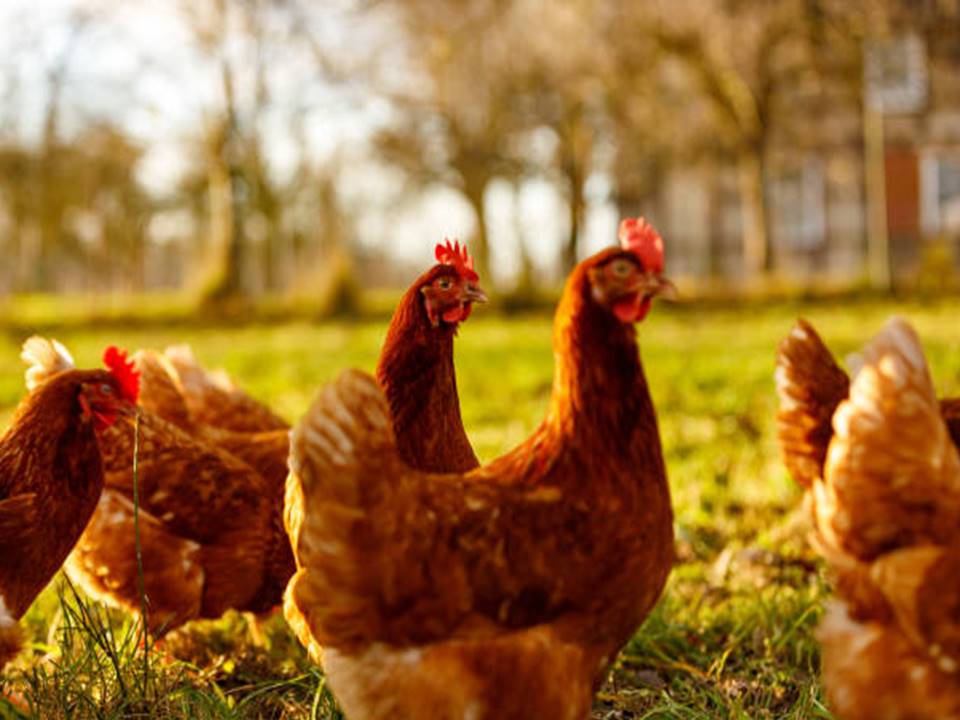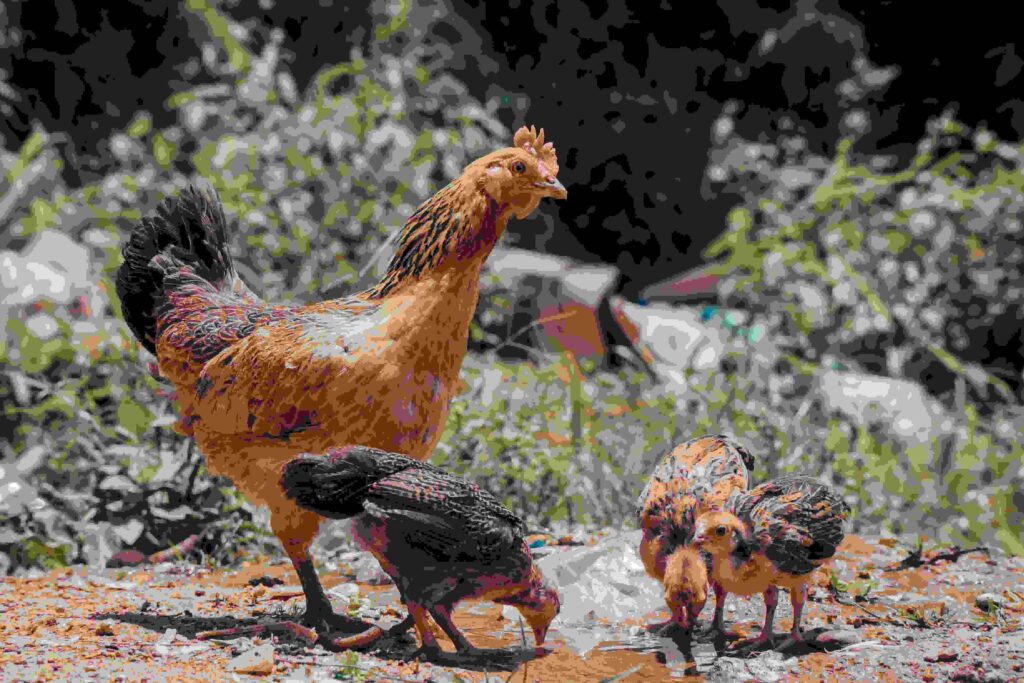- Foreword
- Why Renewable Energy is Essential for Small Farms
- Solar Power: An Accessible Solution
- Wind Energy: Harnessing Natural Power
- Biomass Energy: Utilizing Organic Waste
- Hydropower: Tapping into Natural Water Flow
- Comparing Renewable Energy Options for Small Farms
- Financial Incentives and Grants for Small Farms Adopting Renewable Energy
- Practical Steps for Implementing Renewable Energy on Your Farm
- Case Study: Renewable Energy Transformation on a Small Organic Chicken Farm
- Summary
Foreword
In today’s world, small farms increasingly seek ways to minimize reliance on conventional power sources. Renewable energy offers practical and sustainable alternatives that benefit the environment and can help farmers save on energy costs over time. For those involved in organic farming, such as chicken farming, renewable energy is an opportunity to align farming operations with eco-friendly practices. In this guide, we’ll explore solar, wind, biomass, and other renewable energy options suited to small farms, focusing on practical, real-life applications that help make farms more self-reliant.
Why Renewable Energy is Essential for Small Farms
Small farms can face high operational costs, and energy expenses often make up a significant part of these. By integrating renewable energy sources, farms can reduce dependence on external power grids, ensure a consistent energy supply, and ultimately lower their carbon footprint. This independence is especially valuable for organic chicken farms, where sustainability and environmental responsibility are core values.
Key Benefits of Renewable Energy for Small Farms:
1. Cost Reduction: Renewable energy, though requiring an initial investment, can substantially decrease energy costs in the long run.
2. Energy Independence: For farms in remote or rural locations, renewable energy offers stability and self-sufficiency by providing a reliable, on-site power source.
3. Environmental Impact: Reducing dependency on fossil fuels aligns with sustainable farming practices and lowers greenhouse gas emissions.

Pie chart: Percentage of benefits from renewable energy
Solar Power: An Accessible Solution
One of the most popular renewable energy options for small farms is solar power. Solar energy is clean, reliable, and effective for various farming needs, from powering lighting and heating systems to running small-scale equipment.
- Practical Applications: Solar panels can be installed on rooftops or open fields to power lights, heating for chicken coops, water pumps, and ventilation systems. This is especially beneficial for farms that require regular energy use but may not have consistent access to external power grids.
- Installation and Maintenance: Solar panels are relatively easy to install and require minimal maintenance. Farms can place them on roofs, barns, or even ground mounts, allowing for flexible installation based on space availability.
- Financial Incentives: Many regions offer financial incentives, grants, and tax rebates to encourage solar power adoption, making it an affordable option over time.
Explore how to set up a farm structure that can accommodate solar panels effectively in Setting Up a Small-Scale Chicken Farm. For detailed technical insights on solar energy solutions, refer to the National Renewable Energy Laboratory (NREL), which offers comprehensive resources on solar technologies.
Wind Energy: Harnessing Natural Power
Wind energy is another renewable option that can suit small farms, particularly those located in areas with consistent wind. Small wind turbines generate electricity from wind power, which can be directed toward various farm functions.
- Uses in Small Farms: Wind turbines can be used to power water pumps, ventilate chicken coops, and even support refrigeration systems for farm produce. Farms can combine wind and solar systems for a more resilient, hybrid setup that provides energy even on cloudy days.
- Installation Considerations: Installing a wind turbine requires careful planning, as wind consistency varies significantly by location. Before installation, farms should assess their local climate and available wind data to ensure that wind energy will be a viable long-term solution.
- Environmental Advantages: Wind energy is a zero-emission power source that requires no fuel, making it an environmentally friendly choice. It also aligns well with the sustainable practices often prioritized in organic farming.
For insights on avoiding common challenges in farm management and energy setups, visit Top 10 Common Mistakes in Organic Chicken Farming and How to Avoid Them. Learn more about wind energy technologies and farm-based applications on Energy.gov, a valuable resource for renewable energy best practices and guidelines.

Infographic: Renewable Energy Implementation Steps.
Biomass Energy: Utilizing Organic Waste
For farms that produce significant organic waste, biomass energy can be an excellent solution. Biomass involves converting organic materials, such as chicken manure, crop residues, and food waste into biogas or electricity, which can then be used to power the farm.
- Application on Small Farms: Organic chicken farms are especially well-suited for biomass energy because chicken manure can be repurposed as fuel. Biogas produced from manure can be used to generate heat, run small engines, or even produce electricity, providing a cost-effective and eco-friendly solution.
- Environmental Impact: Biomass energy reduces waste and supports a closed-loop farming system by recycling organic materials. This approach aligns with sustainable farming principles, as it turns waste into a usable resource instead of adding it to landfills or contributing to pollution.
- Installation: A biogas digester or biomass boiler is typically required for processing waste. While initial setup costs may be higher, government grants and incentives are often available to offset these expenses.
Hydropower: Tapping into Natural Water Flow
For farms with access to natural water sources, hydropower provides a consistent and clean energy solution. Small-scale hydropower systems can be highly effective for farms near rivers, streams, or other flowing water sources, offering steady, eco-friendly power.
- Applications in Farming: Hydropower systems can power refrigeration units, lighting, and water pumps, particularly valuable for farms needing a reliable source for cooling or continuous water supply.
- Environmental Impact: Micro-hydropower systems typically have a low environmental footprint, as they work with the natural water flow without significantly altering the landscape. These systems complement the sustainability goals of organic farms.
- Setup and Maintenance: Hydropower setups require a steady water flow, so location and seasonal water variability are essential considerations. Once installed, these systems often need minimal maintenance and provide long-term energy savings.
Comparing Renewable Energy Options for Small Farms
Table: Compare each energy source’s strengths and challenges.
To help farmers decide on the best renewable energy source for their needs, here’s a comparison of the main options: solar, wind, biomass, and hydropower. Each offers unique benefits, applications, and potential challenges, making this table a useful tool for evaluating options.
Energy Source | Applications | Benefits | Drawbacks |
Solar Power | Lighting, heating, water pumping | Low maintenance, scalable | Dependent on sunlight availability |
Wind Energy | Water pumping, lighting, equipment | Reliable in windy areas | Location-dependent, can be noisy |
Biomass | Heat, electricity | Utilizes waste, cost-effective | Requires steady supply of organic material |
Hydropower | Continuous power for refrigeration | Consistent energy, low emissions | Limited to farms with flowing water |
Financial Incentives and Grants for Small Farms Adopting Renewable Energy
Small farms can significantly reduce installation costs for renewable energy systems by utilizing available financial incentives and grants. Many governments, local agencies, and utility companies offer programs to encourage renewable energy adoption among small businesses, including farms.
Federal and State Tax Credits
Tax credits are often provided by governments to support renewable energy investments, covering solar, wind, and biomass installations. These tax incentives help reduce the upfront costs of buying and installing renewable energy systems.
- Solar Investment Tax Credit (ITC): Many farm owners can apply for the Solar ITC, which allows them to claim a portion of their solar installation costs as a tax credit.
- Renewable Energy Production Incentives: In some countries, federal programs provide additional incentives for renewable energy generation. These programs can offer farms a financial boost by compensating them for the energy produced on-site.
State and Local Grants
In addition to federal programs, certain states offer grants, rebates, and low-interest loans specifically for renewable energy installations on small farms.
- Example Program: The U.S. Rural Energy for America Program (REAP) offers financial assistance for small-scale renewable energy projects on farms. Grants cover a portion of installation costs, while low-interest loans provide additional support.
- Utility Rebates: In certain areas, utility companies offer rebates to customers who adopt renewable energy, particularly solar or wind. These rebates can make it more affordable to transition to renewable systems.
Practical Steps for Implementing Renewable Energy on Your Farm
- Conduct an Energy Audit
Before installing a renewable energy system, conduct an energy audit to understand the farm’s current energy consumption and identify areas for improvement. An audit helps in selecting the most effective renewable energy option based on farm energy needs and usage patterns.
- Research Financial Assistance Programs
Explore financial assistance options, including local, state, and federal incentives. Programs like the Solar Investment Tax Credit (ITC) and Rural Energy for America Program (REAP) offer substantial financial support that can reduce installation costs.
- Select the Right Renewable Energy Source
Choosing the right renewable energy system depends on geographic location, climate, and specific farm requirements. For instance:
- Farms with abundant sunlight benefit most from solar energy.
- Farms in windy areas should consider wind turbines for a steady energy supply.
- Farms with flowing water resources might find small-scale hydropower more practical.
- Organic farms with animal waste can use biomass for additional energy savings.
- Installation and Maintenance
Once the right energy source is selected, work with licensed installers to ensure a safe setup. Maintenance varies depending on the system, with solar and hydropower generally requiring minimal upkeep, whereas biomass systems may need more frequent checks.
Case Study: Renewable Energy Transformation on a Small Organic Chicken Farm
Consider the example of a small organic chicken farm in rural Colorado that integrated a renewable energy system. The farm adopted a hybrid setup of solar panels and a small wind turbine, which provided enough power for lighting, water heating, and ventilation systems in chicken coops.
- Energy Savings: By adopting renewable energy, the farm reduced its electricity expenses by 60%. Solar panels covered daytime energy needs, while wind turbines generated power around the clock.
- Environmental Impact: The shift reduced the farm’s carbon emissions, supporting its goal of being a sustainable operation. Customers appreciated the farm’s commitment to environmental stewardship, improving brand loyalty and trust.
- Marketing Advantage: By promoting its renewable energy setup, the farm attracted more customers and even increased its product prices slightly to reflect its eco-friendly approach.
Summary
Adopting renewable energy solutions offers small farms an efficient way to reduce reliance on external power, cut costs, and enhance sustainability. Whether through solar, wind, biomass, or hydropower, renewable energy aligns seamlessly with the values of organic and sustainable farming, including small-scale chicken farms. By investing in these energy options, farmers not only reduce operational expenses but also gain energy independence, improve their environmental impact, and create additional value for customers seeking eco-conscious products. With available financial incentives and practical steps to ease the transition, renewable energy is now a viable and valuable asset for small farm operations.




Well explained..
Thanks for sharing. I read many of your blog posts, cool, your blog is very good.
Thank you for your sharing. I am worried that I lack creative ideas. It is your article that makes me full of hope. Thank you. But, I have a question, can you help me?